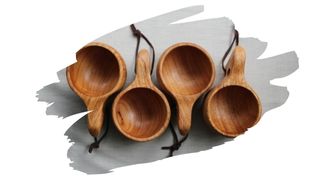There are plenty of food safe finishes out there. And, you could argue that any drying wood finish — that cures into a hard resin — can be deemed food safe.
But there’s a key difference between a food safe wood finish and a food grade one. And this difference means that many food safe finishes aren’t suitable for certain wooden cookware, such as cups.
So, in this post, you will learn what the difference is between a food safe and a food grade wood finish — and what it means for food safety. You will also find out the two best non-toxic wood finishes for wooden cups.

This post may contain affiliate links to products that we receive a commission for (at no additional cost to you). Learn more here.
What Makes A Wood Finish ‘Food Safe’?
Food safe wood finishes can come into indirect contact with food. However, these finishes are not necessarily safe enough for you to prepare food upon.
So, a food safe finish can coat a kitchen countertop or cabinet, without the risk of contaminating your food.
Now this comes with one important caveat; the finish must be cured, for it to be deemed food safe. That’s because once a finish has cured, it is no longer off-gassing or leeching chemical resins.
What Do You Mean By Cured?
A cured wood finish is one that has gone through a chemical change, turning it into a durable coat. You see, a wood finish that cures, (such as Linseed oil), will go through two key stages.
First, it goes through an evaporation process, turning it from a liquid into a firm film. This is the drying stage.
However, once a finish cures, it has gone through a further process in the form of a chemical reaction. This changes that finish into it’s final durable hard coat.
The curing process takes longer than drying. And it isn’t always obvious at a glance (or at a touch) whether a finish has cured.
In the case of Linseed oil, for example, it can take a matter of days for it to dry. Yet, it can take weeks for it to wholly cure.
Related Post: How To Make Linseed Oil Dry Faster (What You Need To Know)
But Why Does This Matter When It Comes To Sealing A Cup?
If you use a food safe wood finish to seal the inside of a cup, you risk some of that finish getting into your drink.
That’s why your wooden cup will need to be sealed with a food grade wood finish instead.
And What Is A Food Grade Wood Finish?
Food grade wood finishes are made from ingredients that are literally safe enough to eat. And they don’t contain toxic chemicals, or anything else too dangerous for human consumption.
So, if any food grade finish happens to get into your food, it doesn’t put your health at risk. Which is why, cutting boards, wooden spoons and spatulas, should be sealed with food grade wood finishes only.
And the same goes for wooden cups.
But Why Does All Of This Matter More For a Wooden Cup?
Well, if that wooden cup is purely decorative, then it doesn’t matter at all. But, if you plan on using that cup to drink liquids out of, then it matters a lot.
Many food safe wood finishes, such as boiled Linseed oil, can become damaged by water. And others still, can even begin to breakdown due to heat.
For example, some lacquer wood finishes can start to melt in temperatures exceeding 120°F (48.9°C). Even certain cold liquids, such as beer and wine, can fizzle lacquer away. Why? Well, because high proof alcohol can break down lacquer finishes.
OK… What’s A Good Food Grade Wood Finish for A Wooden Cup?
The best and most reliable food grade wood finish is pure 100% food grade Mineral oil.
This oil acts like most penetrating oil finishes. It will soak down into wood grain, preventing that lumber from absorbing moisture.
However, this oil does not dry or cure into a solid resin. Instead, it’ll simply coat wood fibers in a moisture-repellent layer of grease.
Related Post: Walrus Oil Vs Mineral Oil: Which One’s Better For Your Cutting Board?
Still, more importantly, Mineral oil is a non-toxic finish, and it is made from refined petroleum distillate. This is a highly refined form of petroleum that’s safe enough for human consumption. Although, it’s mostly used as a laxative, not as a cooking oil (in case you were wondering!).
Is Mineral Oil A Permanent Finish? No it is not. Repeated washing of your wooden cookware will rinse away a lot of that mineral oil. So, it will need to be reapplied often — every 1 to 3 months — depending on frequency of use.
Is Mineral Oil The Only Wood Finish I Can Use? Is There An Alternative?
If Mineral oil doesn’t sound right for you, then you can use Fractionated Coconut oil instead. This is a specially filtered version of Coconut oil, that won’t go rancid like the culinary original.
You can learn more about Fractionated Coconut oil — and why it’s a good wood finish — by checking out this post: What Will Fractionated Coconut Oil Do To Your Cutting Board?
To Wrap Up, Here Are The 3 Key Takeaways From This Post…
1). A food safe wood finish can come into indirect contact with food or drink.
2) But, a food grade finish is safe enough to come into direct contact with food or drink.
3). Some examples of food grade wood finishes are pure food grade Mineral oil and Fractionated Coconut oil.
References:
FDA Compliant, Food Grade and Food Safe | Industrial Specialties Mfg. & IS MED Specialties
Hagenmaier, Robert D., and Philip E. Shaw. “Permeability of shellac coatings to gases and water vapor.” Journal of Agricultural and Food chemistry 39.5 (1991): 825-829.



